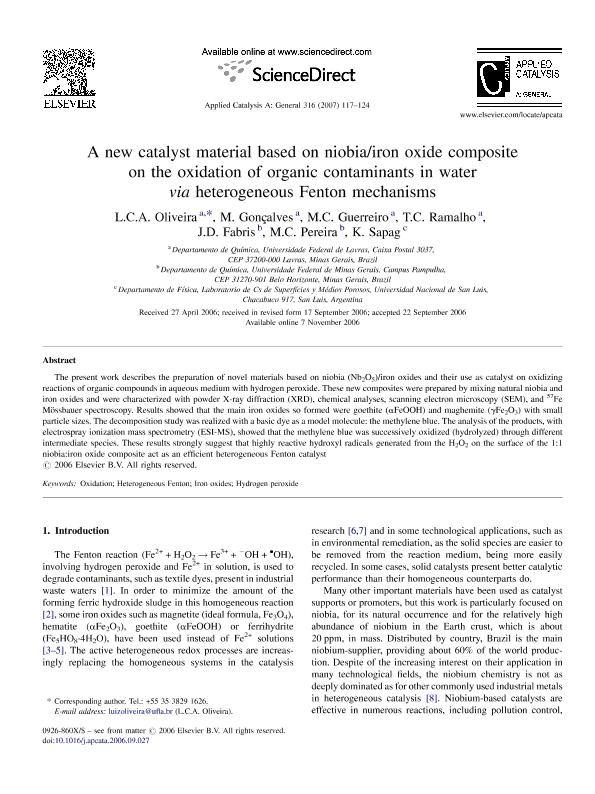Mostrar el registro sencillo del ítem
dc.contributor.author
Oliveira, L. C. A.
dc.contributor.author
Gonçalves, M.
dc.contributor.author
Guerreiro, M. C.
dc.contributor.author
Ramalho, T. C.
dc.contributor.author
Fabris, J. D.
dc.contributor.author
Pereira, M. C.
dc.contributor.author
Sapag, Manuel Karim

dc.date.available
2020-10-29T20:50:49Z
dc.date.issued
2007-01
dc.identifier.citation
Oliveira, L. C. A.; Gonçalves, M.; Guerreiro, M. C.; Ramalho, T. C.; Fabris, J. D.; et al.; A new catalyst material based on niobia/iron oxide composite on the oxidation of organic contaminants in water via heterogeneous Fenton mechanisms; Elsevier Science; Applied Catalysis A: General; 316; 1; 1-2007; 117-124
dc.identifier.issn
0926-860X
dc.identifier.uri
http://hdl.handle.net/11336/117207
dc.description.abstract
The present work describes the preparation of novel materials based on niobia (Nb2O5)/iron oxides and their use as catalyst on oxidizing reactions of organic compounds in aqueous medium with hydrogen peroxide. These new composites were prepared by mixing natural niobia and iron oxides and were characterized with powder X-ray diffraction (XRD), chemical analyses, scanning electron microscopy (SEM), and 57Fe Mössbauer spectroscopy. Results showed that the main iron oxides so formed were goethite (αFeOOH) and maghemite (γFe2O3) with small particle sizes. The decomposition study was realized with a basic dye as a model molecule: the methylene blue. The analysis of the products, with electrospray ionization mass spectrometry (ESI-MS), showed that the methylene blue was successively oxidized (hydrolyzed) through different intermediate species. These results strongly suggest that highly reactive hydroxyl radicals generated from the H2O2 on the surface of the 1:1 niobia:iron oxide composite act as an efficient heterogeneous Fenton catalyst.
dc.format
application/pdf
dc.language.iso
eng
dc.publisher
Elsevier Science

dc.rights
info:eu-repo/semantics/openAccess
dc.rights.uri
https://creativecommons.org/licenses/by-nc-sa/2.5/ar/
dc.subject
HETEROGENEOUS FENTON
dc.subject
HYDROGEN PEROXIDE
dc.subject
IRON OXIDES
dc.subject
OXIDATION
dc.subject.classification
Ingeniería Química

dc.subject.classification
Ingeniería Química

dc.subject.classification
INGENIERÍAS Y TECNOLOGÍAS

dc.title
A new catalyst material based on niobia/iron oxide composite on the oxidation of organic contaminants in water via heterogeneous Fenton mechanisms
dc.type
info:eu-repo/semantics/article
dc.type
info:ar-repo/semantics/artículo
dc.type
info:eu-repo/semantics/publishedVersion
dc.date.updated
2020-08-05T16:45:43Z
dc.journal.volume
316
dc.journal.number
1
dc.journal.pagination
117-124
dc.journal.pais
Países Bajos

dc.journal.ciudad
Amsterdam
dc.description.fil
Fil: Oliveira, L. C. A.. Universidade Federal de Lavras. Departamento de Química; Brasil
dc.description.fil
Fil: Gonçalves, M.. Universidade Federal de Lavras. Departamento de Química; Brasil
dc.description.fil
Fil: Guerreiro, M. C.. Universidade Federal de Lavras. Departamento de Química; Brasil
dc.description.fil
Fil: Ramalho, T. C.. Universidade Federal de Lavras. Departamento de Química; Brasil
dc.description.fil
Fil: Fabris, J. D.. Universidade Federal de Minas Gerais. Departamento de Química; Brasil
dc.description.fil
Fil: Pereira, M. C.. Universidade Federal de Minas Gerais. Departamento de Química; Brasil
dc.description.fil
Fil: Sapag, Manuel Karim. Consejo Nacional de Investigaciones Científicas y Técnicas. Centro Científico Tecnológico Conicet - San Luis. Instituto de Física Aplicada "Dr. Jorge Andrés Zgrablich". Universidad Nacional de San Luis. Facultad de Ciencias Físico Matemáticas y Naturales. Instituto de Física Aplicada "Dr. Jorge Andrés Zgrablich"; Argentina
dc.journal.title
Applied Catalysis A: General

dc.relation.alternativeid
info:eu-repo/semantics/altIdentifier/doi/http://dx.doi.org/10.1016/j.apcata.2006.09.027
dc.relation.alternativeid
info:eu-repo/semantics/altIdentifier/url/https://www.sciencedirect.com/science/article/abs/pii/S0926860X06007009
Archivos asociados
